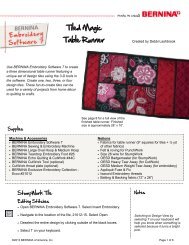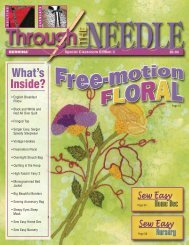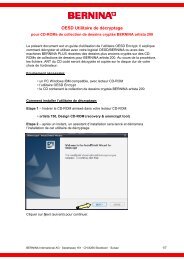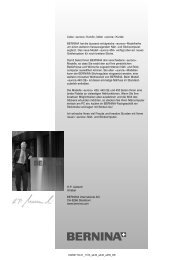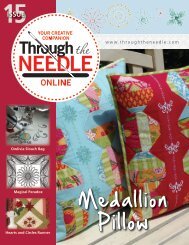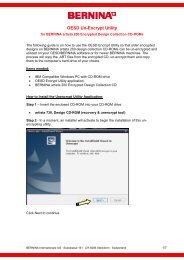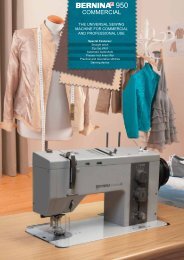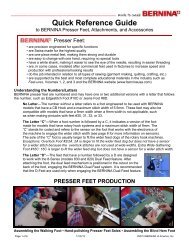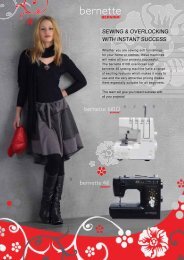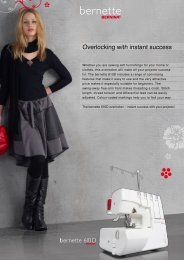Create successful ePaper yourself
Turn your PDF publications into a flip-book with our unique Google optimized e-Paper software.
Introduction to Fiberella Techniques5Fiberella Technique I & IIIWelcome to the amazing world of <strong>BERNINA</strong> Needle punch. Needle punch is an exciting way to create surface design, local embellishment and dramatictexture. You can also build felt fabric from fibers and create wash-able three dimensional ornaments. These are wonderful elements added to your sewingand embroidery projects; and fantastic as pure Needle punch.To begin here’s a selection of useful Fiberella Techniques. Together these simple techniques offer a platform for endless variation and play.You’ll learn basic skills and become comfortable with the many easy-to-use capabilities built into your new <strong>BERNINA</strong> <strong>Punch</strong> <strong>Tool</strong> set.After practicing each technique take a few moments to notice the accompanying photos suggesting technique variations. Let these stir your imagination.You can combine more than one technique on a single surface. Experiment! Add something of your own into the mix. If you change your selection of materials,cut materials differently or perform tasks in a different sequence… what happens? This is the joy of Needle punch. Just give something new a try. Noticewhat the materials prefer to do. Soon you’ll be coming up with unique techniques based on your own observations. We are all a part of this adventure.Enjoy the experience of having color and texture come to life at your fingertips. The <strong>BERNINA</strong> <strong>Punch</strong> <strong>Tool</strong> expands creative horizons for everyone.Paula Scaffidi AKA Fiberellawww.fiberella.comTechnique I, snippet added, worked on a folded base.EN_1106_033679.51.00 for sewing machines with rotary hook • <strong>BERNINA</strong> <strong>Punch</strong> <strong>Tool</strong> <strong>#45</strong>
Joyful ColorÜberschrift 16Pull a Shingle of Roving• Separate fibers at torn or cut end of roving log.• Hold roving gently at desired length from end.• Use opposite hand to select a small fiber section at cut or torn end.Apply firm fingertip pressure with pulling hand only.• Separate hands sliding a shingle of roving out of the log and into your fingertips.• Gently hold roving closer or farther down the log for shingle length control.• Use smaller or larger fingertip(s) to control shingle width.Finger-Tap Method: pull & place shingles… all in one step• Gently hold roving log in one hand at the desired shingle length.• Lower roving end to fabric at location for placement.• Use fingertip from opposite hand. Firmly press selected width of the roving against fabric.• Pull roving log away from fabric.• A shingle is laid down at desired location; with selected width and length.Split Roving Lengthwise• Halfway down roving log separate a very slender section along edge.• Carefully peel away from larger log.• Make thinner by stretching and/or add twist for strength.Roving or unspun fiber is ideal for Needle punchEN_1106_033679.51.00 for sewing machines with rotary hook • <strong>BERNINA</strong> <strong>Punch</strong> <strong>Tool</strong> <strong>#45</strong>
I Surface DesignÜberschrift 17Transform plain fabric into a unique artistic ingredient. The final effect can show some or none of theoriginal fabric.Materials & <strong>Tool</strong>s--wool roving or unspun fiber in a variety of colors--several pieces medium weight wool fabric approximately 8” x 10” (20cm x 25cm) or larger--pinking shears or pinking rotary blade and cutting mat--hoop optional--white style punch needlesSettings• Foot Height: begin at approximately Level 2 as marked on the foot. Adjust as needed. Foot soleshould glide just above the materials at all times for this technique.• Needle Number: all three• Needle Up: great for jumping from shingle to shingle• Motor Speed: moderate… medium low to medium high• Fabric Movement: slow… for lots of needle penetrationsIdeas for roving placement:diagonal, watercolor plaid, Shibori, a painter’s brushstrokes,etc.EN_1106_033679.51.00 for sewing machines with rotary hook • <strong>BERNINA</strong> <strong>Punch</strong> <strong>Tool</strong> <strong>#45</strong>
I Surface Design8Surface Design TechniqueColor until your heart is content…avoiding thick applications• Apply roving shingles to fabric without overlapping shingles.• Pat down with hand.• Adjust punch foot height at about Level 2: bottom of sole coasting just above shingles.• Maintain flat base: Needle punch each shingle one-at-a-time from end-to-end. Use moderatemotor speed and slow fabric movement. OR… <strong>Punch</strong> shingles from center out toward one end;return to center and punch toward opposite end. Roving shingles shrink in length during thisprocess. This is good. <strong>Punch</strong> needles gather fiber to deliver below the base fabric. Take a look!• Needle punch each shingle until it shows as fuzz underneath. Little circular motions are alsohelpful to send fibers below.• Add another layer of shingles. It’s fine to overlap the already needlepunched shingles. Avoidoverlapping new shingles with each other (often causes base to pucker).• Pat down with hand; adjust <strong>Punch</strong> <strong>Tool</strong> height as needed.• Needle punch shingles again as before.• Build color to please your eye.• Opt to apply fibers to both sides of your fabric. This further strengthens the interlocking felting ofthe fibers.Place one or several shingles over already needlepunchedlayers.Twist the shingle tip. Leave interesting open-space shapes.Prepare your “New Fabric”• Before washing trim fabric edges with pinking shears or pinking blade.• Hand or machine wash in warm to hot water; with laundry soap or detergent.• Machine drying shrinks, thickens and strengthens Needle punch work; or air dry.• Free-hand embroidery adds more strength to fabric for hard wearing items such as everydayhandbags; and it adds another nice design element.• You can Needle punch roving over any light (not dense) stitching you’d like to “blur.”• It’s possible to add more roving after washing if desired; then wash again.Fiberella Technique I Detail: Ode to ArgyleEN_1106_033679.51.00 for sewing machines with rotary hook • <strong>BERNINA</strong> <strong>Punch</strong> <strong>Tool</strong> <strong>#45</strong>
Expressive LinesÜberschrift 19Needle punch offers exciting yarn effects. Let’s explore!Materials & <strong>Tool</strong>s--fine, medium and large yarns to flow through foot openings. Friendly fiber content: wool, nylon,rayon, mohair, alpaca; and yarn blends with more than 60% friendly fibers for best results.--roving logs split lengthwise to fit large yarn guide--base fabrics: silk noil or medium weight wool--hoop to fit easily under <strong>Punch</strong> <strong>Tool</strong> Foot--yarn insertion tool--red style punch needles--free-standing thread stand with a large upper loop--optional marking tools if desired for repeat pattern or designAdd rows in any directionA yarn over one yarn is fine.Avoid crossing the same spot a third timeEN_1106_033679.51.00 for sewing machines with rotary hook • <strong>BERNINA</strong> <strong>Punch</strong> <strong>Tool</strong> <strong>#45</strong>
II Expressiv Lines10SettingsMedium yarn enters back of foot.Large and fine materials enter front of foot.• Foot Height: foot sole gliding with a little extra space above yarn for easy turning and for layering;yet still holding yarn in place for Needle punch.• Needle Number: Use all three for most yarn applications. Exception: use center needle only formedium and fine yarn on delicate base fabrics.• Needle stop down: for continuous line designs• Needle stop up: for short line segments• Motor Speed: medium high. Exception: slow it down a little for smaller, tighter designs.• Fabric Movement: slow and steady… you want lots of needle penetrations all along the yarn line.You should have a well defined yarn line underneath.• Hoop: ALWAYS a good idea with linear material to avoid base puckering; and free hands to onlysteer fabric for design. CAUTION: raise needles and foot to slide hoop onto machine bed; and toremove hoop. This prevents accidentally hitting needle tips.• Use knee lift when sliding hoop in and out of the work area.• Attach outer guide for yarns.In Fiberella Technique II, it’s fun to create spaces and fill them.When design fills and thickens, eliminate hoop.Add strength: Needle punch surface again.Expressive Line TechniqueTwo small yarns at once!• Hoop base fabric.• Insert medium yarn from thread stand loop into guide on back of foot.• Needle punch square shapes, medium size to your eye and hand. Leave spaces between. Formsome clockwise; others counterclockwise. Find a size you like for the diameter of yarn used.• Remove medium yarn; insert large yarn; adjust foot height to allow large yarn to travel acrossmedium yarn already needle-punched.• Needle punch a much larger square to overlap several medium squares.• Remove large yarn. Insert fine yarn.• Adjust foot height to overlap fine yarn over fine yarn.• Needle punch small squares. These can overlap each other be separate or continuous line. Fillsome empty spaces. Varying yarn thickness adds visual depth.• Continue with no rules filling by eye, adding new yarns in any way you please.• Repeat this exercise on new fabric adding curves in any way you imagine.• Try other shapes like circles, ovals or ellipses, triangles, etc.EN_1106_033679.51.00 for sewing machines with rotary hook • <strong>BERNINA</strong> <strong>Punch</strong> <strong>Tool</strong> <strong>#45</strong>
Textural TemptationsÜberschrift 111Materials & <strong>Tool</strong>sCreate a rich field of texture for the fingertips.Add strength: Needle punch surface again.--base fabric: several pieces wool fabric approximately 8” x 10” (20cm x 25cm) or larger; &/or silk noilwith thin polyester batting underneath to better “catch” needlepunched strips.--rotary cutter, ruler and mat; straight and pinking rotary blade--doupioni silk: stack a variety of colors; use straight rotary blade to cut bias strips 7mm or ¼ inchwide and at least 8 inches long. Cut additional wavy bias strips about 2 ½ inches or 6cm wide; andsome about 1 ½ inch or 4cm wide.--wool: cut loosely woven wool fabric into ¼ inch wide or 7mm strips across the weft (selvedge toselvedge) with pinking rotary blade.--flat yarns: approximately 7mm wide. Best choices include: nylon content with knit-structure; flatyarns with loose wool and flat novelty yarns (hairy, extra strands)--optional 7mm silk or polyester sheer ribbon--red style punch needles--yarn insertion tool--hoop recommended for 7mm strips--hoop optional for wide silk stripsEN_1106_033679.51.00 for sewing machines with rotary hook • <strong>BERNINA</strong> <strong>Punch</strong> <strong>Tool</strong> <strong>#45</strong>
III Textural Temptations12SettingsReposition project for narrow or wide needle paths.• Foot Height: as needed; a little extra space between the bottom of foot and strips so silk cangather or ruche; wool can be overlapped on itself… like piping icing on a cake!• Needle Number: all three• Needle Up: for small separate designs and short strips• Needle Down: for continuous line designs and long strips• Motor Speed: medium high for wool; high for silk• Fabric Movement: slow• Knee Lift: for placement of wide silk strips• Outer guideColor should show on underside.Textural Temptations Technique• Use fabric color as part of your design; or cover all of it.• Begin design using a variety of 7mm materials. Insert a 7mm strip into front and out bottom offoot.• Holding the tail, Needle punch several times moving fabric back and forth a little to secure it.Later you can clip, trim or Needle punch tail as desired.• Begin your design direction by moving the fabric. Strategy is to divide or outline areas; then fillthem.• Insert 7mm silk strips. High motor speed, slow fabric movement and room under the foot help toruche.• Adjust foot height to Needle punch wool strips one or more times over each other.• Needle punch matte wool strips to surface with shiny silk as desired.• Add flat yarns to outline or fill a few areas.• Add optional 7mm silk or polyester ribbon. Complete low relief texture.• Create medium and tall textures with medium and wide strips of silk. Add to your preferred side.Needle punch down the center or along an edge of these wavy strips.In Fiberella Technique III, apply strips; Needle punch areas to further secure and to flatten as desired.EN_1106_033679.51.00 for sewing machines with rotary hook • <strong>BERNINA</strong> <strong>Punch</strong> <strong>Tool</strong> <strong>#45</strong>
III Textural Temptations13• Optional Reverse Needle punch for wool base fabric: To further secure 7mm strips flip fabric overso the underside faces the ceiling. Use slow speed• Follow a silk strip path and Needle punch a thin line: use sideways fabric motion across thepunch plate. Stop to inspect visual results underneath. Proceed as desired.NOTE: on silk noil base polyester batting will reverse Needle punch.• Add optional free-motion or decorative stitching; needlepunched yarn or roving twists can furthersecure strips while adding design interest.In Fiberella Technique III create a final field of varying heights. Assorted strip widths stand-up alongside flattened areas.Needle punch again:all over for flat effects and intermittently in high texture tofurther secure.EN_1106_033679.51.00 for sewing machines with rotary hook • <strong>BERNINA</strong> <strong>Punch</strong> <strong>Tool</strong> <strong>#45</strong>
Felt FabricÜberschrift 114Roving colors naturally merge delivering beauty. Create felt fabric two ways: directly on the punchplate or on stabilizer.Materials & <strong>Tool</strong>s--Roving in a variety of colors--OESD’s Aqua Mesh (not Aqua Mesh Plus)--Optional Yarns--White style punch needlesSettings• Foot Height: just high enough to clear the patted down roving shingles• Needles: all three• Needle stop down: to hold your place if you pause• Motor Speed: medium high to high• Fabric Movement: slow and in sections as you will see!Use Fiberella Technique IV to create thick and thin feltscarves: thin roving layers create drape<strong>Punch</strong> needles hold and carry materials first encountered, delivering coloration to the surface below. Lovely blurrycolors emerge.EN_1106_033679.51.00 for sewing machines with rotary hook • <strong>BERNINA</strong> <strong>Punch</strong> <strong>Tool</strong> <strong>#45</strong>
IV Felt Fabric15Felt Fabric TechniquesTop color travels to undersideCreate Felt on the <strong>Punch</strong> Plate• Think of baking a cake. Imagine two layers of cake plus a layer of icing.• Pull several shingles of roving two fingertips wide and about four inches/ 10 cm long. (Seetechnique page 6).• Place shingles side-by-side touching or barely overlapping lengthwise; all in the same direction.Let’s call this east-west. This is the bottom layer of your cake.• Pull another set of similarly-sized roving shingles. Place these to cover your bottom layer completelybut in another direction. Let’s call this your “north-south” second layer of cake.• Add a third layer of shingles, again east-west. Since this is your “icing” layer have fun with colorselection and placement. Shingles can be very small, delicate &/or with some large shinglesmixed in.• Pat down all three layers.• Adjust foot height to small clearance.• Needle punch a large WWWW to “baste” the layers together.• Needle punch entire surface. Work in columns moving fabric mostly toward and away from you.• Turn fabric to 90 degree rotation. Needle punch columns same as in last step.• Third needle pass: circular motions across entire surface.• Peek underneath. “Icing colors” affect colors on blurry side below. Hidden beauty there!• Use side you prefer for your project.• Optional: blur “icing colors” …Needle punch with icing layer facing punch plate for step 10.• Optional: with blurry side facing ceiling; add extra shingles for crisp color.• Wash and dry same as project will be cleaned. The hotter the water and the more friction andsoap, the thicker the felt.Reverse needle felting, was used to affect coloration.With or without stabilizer, hold flat to Needle punch WWWFiberella Technique IV is lovely as a base for decorative stitch.EN_1106_033679.51.00 for sewing machines with rotary hook • <strong>BERNINA</strong> <strong>Punch</strong> <strong>Tool</strong> <strong>#45</strong>
IV Felt Fabric16Create Felt on Stabilizer• Use large sheet of recommended stabilizer as base. Repeat as before: layer three layers ofshingles in alternating directions; three Needle punch passes across the surface.Tip: after applying each shingle layer pat down and hold to the light. Identify thin spots and addshingles. Practice controlling desired shingle thickness, making even layers to achieve thick orthin felt for your artistic purposes.• Easily use up roving remnants to layer big sheets.• If you’re not going to Needle punch immediately, lay paper on top. Roll to store until your nextNeedle punch session.• Washing machine can help complete the task after light Needle punch.ENJOY!Paula Scaffidi AKA FiberellaSummerfield Communications Inc.6805 Fegan Road,Summerfield, NC 27358www.fiberella.comEN_1106_033679.51.00 for sewing machines with rotary hook • <strong>BERNINA</strong> <strong>Punch</strong> <strong>Tool</strong> <strong>#45</strong>



